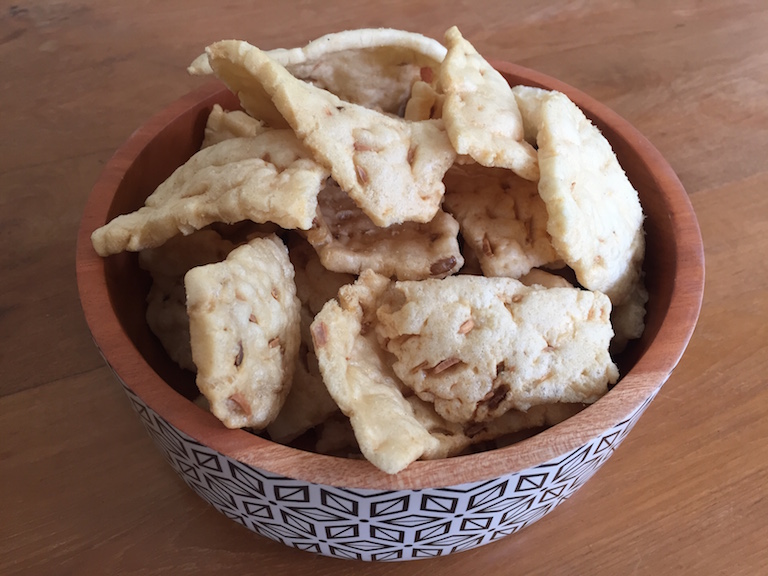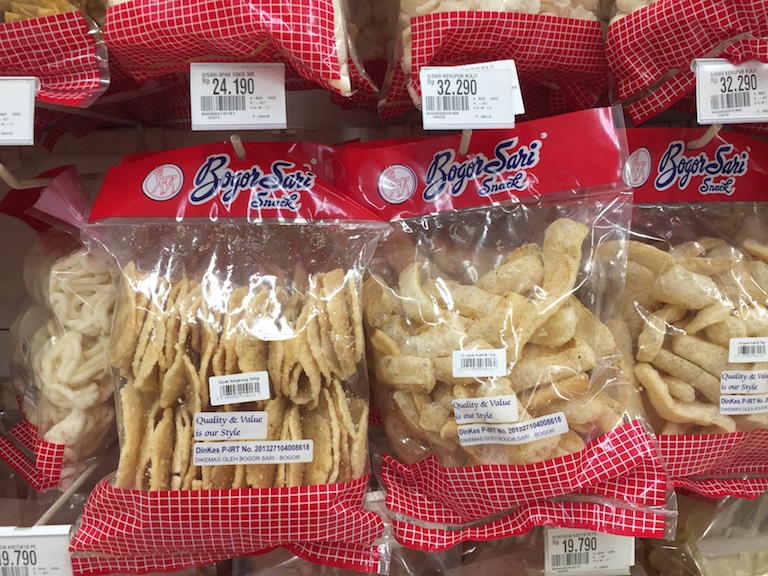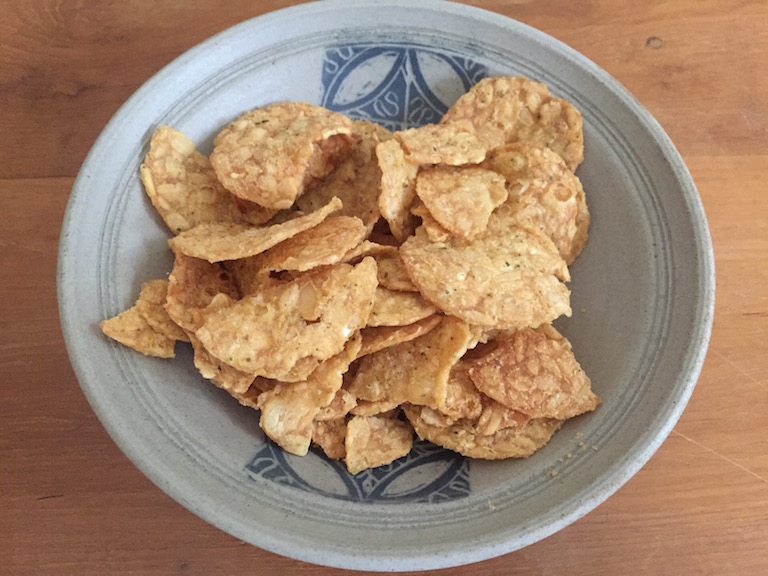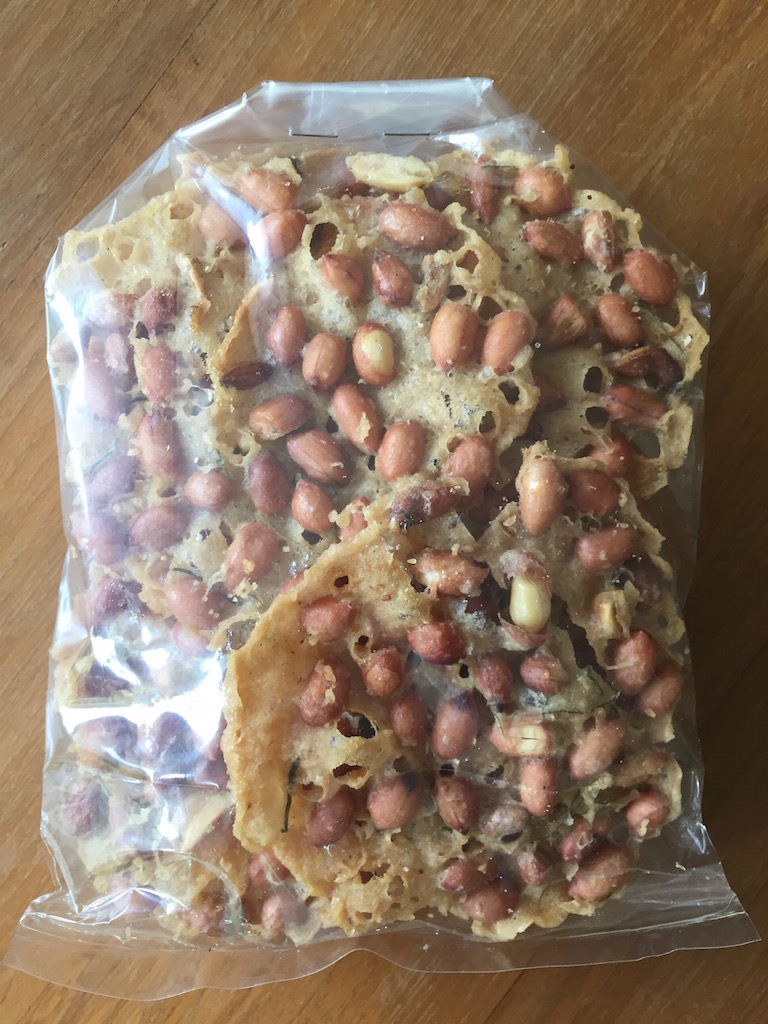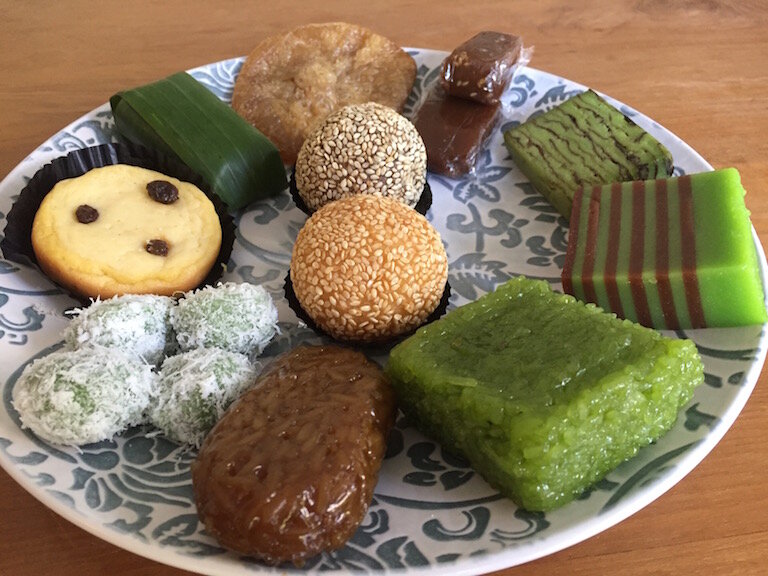The Story of Krupuk and Other Traditional Indonesian Snacks
If you live in Indonesia, you will no doubt have seen many *kaki lima with colourful tins of styrofoam-looking crackers attached to the side. This is a common sight here in Jakarta and I know long after we leave, it will remain an endearing memory.
A little 'toko' (shop) that sells an assortment of everyday needs, including krupuk (stored in the colourful tins)
These popular snacks are known as *Krupuk and versions of this style of cracker are also common in Malaysia, The Philippines and even in The Netherlands due to Indonesia's historic colonial ties with the Dutch.
What are Krupuk?
Krupuk are crunchy savoury snacks mostly made from starch and often flavoured with fish, seafood (prawns, squid), onion, chilli as well as other flavourings (including possibly the flavour enhancer, MSG E621). They are deep-fried and eaten as a snack or as an accompaniment with meals.
Krupuk tempe are a variety of cracker which include soy beans in their recipe
A very popular afternoon snack in Jakarta, Asinan Sayuran can be purchased from street vendors each afternoon from 2pm. Asinan Sayuran is always served with Krupuk mie, on the side and sambal (pictured here in the plastic bag)
Some Indonesian dishes including Nasi Goreng, Gado-Gado, Asinan Sayuran, Bubur Ayam, Karedok and some soups are served with either whole - or broken pieces of krupuk as toppings. This adds an extra crunch to the dish.
Which Krupuk will be Your favourite?
Just as our supermarkets back home stock a veritable range of savoury snack foods, here in Jakarta, a wander through the equivalent section of a local supermarket and you'll be met with an entire wall (or more) of traditional Indonesian snacks.
Krupuk can be purchased ready to eat (conveniently pre-fried for snacking convenience), or in their dried form (as pictured here)
Take some time to check them out. Read their ingredients, which are often translated into English (note ‘flavourings’ will most likely include MSG) and ask your local friends which are their favourite Krupuk. Will it be the ever-popular Krupuk blek or will it be something more exotic? Different regions of Indonesia have different Krupuk specialities!
Here are some Krupuk you must try:
Krupuk udang - Universally known as the shrimp- or prawn cracker. Even if the following Krupuk are new to you, no doubt you'll be familiar with this one.
An example of 'premium' shrimp crackers sold at a local Jakarta supermarket
Krupuk udang
Krupuk blek (also known as Krupuk uyel, Krupuk kampung, or Krupuk putih) - A cassava starch cracker that is ubiquitous throughout Indonesia.
Krupuk ikan - A traditional fish cracker, especially popular in areas of Indonesia where fish farming is prevalent, including Palembang, Bangka, Cirebon and Sidoarjo.
Krupuk bawang - A traditional onion/garlic cracker, generally eaten as an accompaniment with meals.
Krupuk Bawang
Krupuk mie - A yellow cracker made from noodle-like paste (simiar to Krupuk blek). This type of Krupuk is often used as an accompaniment for asinan and is especially popular in Jakarta where it is sold road-side or at local markets.
Krupuk mie ('mie' means 'noodle' in Bahasa Indonesia)
And maybe not for everyone… Krupuk kulit is a cracker made from dried cattle skin. It is particularly popular in the Minangkabau area of West Sumatra.
Packets of Krupuk cassava and Krupuk kulit
Krupuk versus Kripik
This toko kecil (little shop) in South Jakarta sells solely Kripik made from Singkong, or Cassava. The vendor's name is Pak Manto and if you get that craving for Cassava chips, you can call him anytime and have your snacks delivered to your door!
Although the names are quite similar, Krupuk refers to a relatively large cracker generally made from the dried paste of a starchy mixture, whereas, (in most cases) Kripik are made from thinly sliced, sundried vegetables that have not been mixed with anything else apart from some seasonings. Most common types of Kripik include Sweet potato, Potato and Cassava (Singkong).
In essence, Kripik are the Indonesian equivalent of the Western ‘chip’ (or ‘crisp', depending on where you’re from!)
Apart from Kripik kentang (potato chips), Cassava, Sweet Potato and Tempe chips are also widely available in supermarkets across Indonesia
Kripik singkong (cassava chips)
Kripik ubi (sweet potato chips)
Kripik tempe (made from fermented soy beans)
And if you're still looking for even more Traditional Snacks of Indonesia, then you must also try Emping and Rempeyek.
Emping are a type of cracker made from melinjo seeds (and hence have quite a bitter taste). The plain version of Emping regularly accompany the dish Gado-Gado.
Sweet and Spicy versions or Emping are also available at your local supermarket in Jakarta and might I must say, they are both delicious!
Emping manis are sweet crackers with a slightly bitter flavour. The sweetness is due to caramelised palm sugar. They are a very moorish snack!
Like a little bit of heat? Then you have to try these delicious sweet and spicy Emping known as 'Emping Pedas Lebar' (which translates as Spicy Wide Emping)
The final Traditional snack of Indonesia that you need to try is Rempeyek. I first tasted Rempeyek when I visited the East Java city of Malang on my way to a volcano climb.
We stopped at a little *warung for lunch and our pre-lunch snack consisted of a variety of Krupuk and a very interesting looking cracker covered in peanuts and seasoned with slivers of kaffir lime leaf. This new and seriously tasty snack was Rempeyek kacang (pictured below) and would become a snack that I would seek out and seldom find. Unlike Krupuk which is mass produced, the production of Rempeyek is a cottage industry and hence this type of cracker can only be found in local markets and little shops.
In essence, Rempeyek are a flour-based cracker most commonly sprinkled with a coating of peanuts. Other varieties include anchovies or tiny shrimp in their recipes.
Happy Snacking!
Rempeyek kacang
*Kaki lima - a traditional food cart
*Krupuk - various spelling including Kerupuk, Kroepoek
*Warung - a small local-style cafe/eatery
Words: Jo Stevens Photography: a journey bespoke




